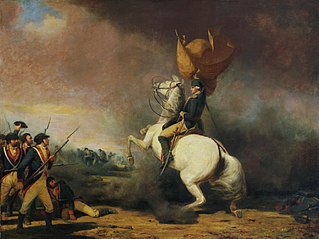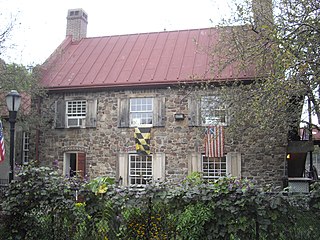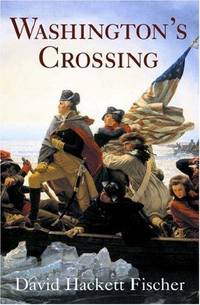
The American Revolutionary War, also known as the Revolutionary War or American War of Independence, was a major war of the American Revolution. Widely considered as the war that secured the independence of the United States, fighting began on April 19, 1775, followed by the Lee Resolution on July 2, 1776, and the Declaration of Independence on July 4, 1776. The American Patriots were supported by the Kingdom of France and, to a lesser extent, the Kingdom of Spain and the Dutch Republic, in a conflict taking place in North America, the Caribbean, and the Atlantic Ocean.

The Battle of Princeton was a battle of the American Revolutionary War, fought near Princeton, New Jersey on January 3, 1777, and ending in a small victory for the Colonials. General Lord Cornwallis had left 1,400 British troops under the command of Lieutenant Colonel Charles Mawhood in Princeton. Following a surprise attack at Trenton early in the morning of December 26, 1776, General George Washington of the Continental Army decided to attack the British in New Jersey before entering the winter quarters. On December 30, he crossed the Delaware River back into New Jersey. His troops followed on January 3, 1777. Washington advanced to Princeton by a back road, where he pushed back a smaller British force but had to retreat before Cornwallis arrived with reinforcements. The battles of Trenton and Princeton were a boost to the morale of the patriot cause, leading many recruits to join the Continental Army in the spring.

The Battle of Trenton was a small but pivotal American Revolutionary War battle on the morning of December 26, 1776, in Trenton, New Jersey. After General George Washington's crossing of the Delaware River north of Trenton the previous night, Washington led the main body of the Continental Army against Hessian auxiliaries garrisoned at Trenton. After a brief battle, almost two-thirds of the Hessian force were captured, with negligible losses to the Americans. The battle significantly boosted the Continental Army's waning morale, and inspired re-enlistments.

The Old Stone House is a house located in the Park Slope neighborhood of Brooklyn, New York City. The Old Stone House is situated within the J. J. Byrne Playground, at Washington Park, on Third Street between Fourth and Fifth Avenues. Gowanus Creek once ran nearby, but today the southeastern branch of the Gowanus Canal ends 1,300 feet (400 m) west of the house.

The New York and New Jersey campaign in 1776 and the winter months of 1777 was a series of American Revolutionary War battles for control of the Port of New York and the state of New Jersey, fought between British forces under General Sir William Howe and the Continental Army under General George Washington. Howe was successful in driving Washington out of New York, but overextended his reach into New Jersey, and ended the active campaign season in January 1777 with only a few outposts near the city. The British held New York Harbor for the rest of the war, using it as a base for expeditions against other targets.

The Battle of Harlem Heights was fought during the New York and New Jersey campaign of the American Revolutionary War. The action took place on September 16, 1776, in what is now the Morningside Heights area and east into the future Harlem neighborhoods of northwestern Manhattan Island in what is now part of New York City.

The Landing at Kip's Bay was a British amphibious landing during the New York Campaign in the American Revolutionary War on September 15, 1776. It occurred on the East River shore of Manhattan north of what then constituted New York City.

Washington Crossing State Park is a 3,575-acre (14 km2) New Jersey state park that is part of Washington's Crossing, a U.S. National Historic Landmark area. It is located in the Washington Crossing and Titusville sections of Hopewell Township in Mercer County, north of Trenton along the Delaware River. The park is operated and maintained by the New Jersey Division of Parks and Forestry. It is supported by the Washington Crossing Park Association, a friends group that works to preserve, enhance, and advocate for the park.

The Battle of Pell's Point, also known as the Battle of Pelham, was a skirmish fought between British and American troops during the New York and New Jersey campaign of the American Revolutionary War. The conflict took place in what is now part of Pelham Bay Park in the Bronx, New York City and the towns of Pelham Manor and Pelham in Westchester County, New York.
The history of New York City (1665–1783) began with the establishment of English rule over Dutch New Amsterdam and New Netherland. As the newly renamed City of New York and surrounding areas developed, there was a growing independent feeling among some, but the area was decidedly split in its loyalties. The site of modern New York City was the theater of the New York Campaign, a series of major battles in the early American Revolutionary War. After that, the city was under British occupation until the end of the war and was the last port British ships evacuated in 1783.

Washington's Crossing is a Pulitzer Prize-winning book written by David Hackett Fischer and part of the "Pivotal Moments in American History" series. It is primarily about George Washington's leadership during the 1776 campaign of the American Revolutionary War, culminating with George Washington's crossing of the Delaware River and the subsequent campaign, with the Battle of Trenton, the Battle of the Assunpink Creek, and the Battle of Princeton.

George Washington's crossing of the Delaware River occurred on the night of December 25–26, 1776, during the American Revolutionary War, was the first move in a surprise attack organized by George Washington against Hessian forces, which were German auxiliaries aiding the British, in Trenton, New Jersey, on the morning of December 26. Planned in secrecy, Washington led a column of Continental Army troops from today's Bucks County, Pennsylvania across the icy Delaware River to today's Mercer County, New Jersey, in a logistically challenging and dangerous operation.
John Haslet was an American Presbyterian clergyman and soldier from Milford, in Kent County, Delaware. He was a veteran of the French and Indian War and an officer of the Continental Army in the American Revolution, serving as the first Colonel of the 1st Delaware Regiment. He was killed in action at the Battle of Princeton.

The Battle of the Assunpink Creek, also known as the Second Battle of Trenton, was a battle between American and British troops that took place in and around Trenton, New Jersey, on January 2, 1777, during the American Revolutionary War, and resulted in an American victory.

The Fortification of Dorchester Heights was a decisive action early in the American Revolutionary War that precipitated the end of the siege of Boston and the withdrawal of British troops from that city.
The 3rd Virginia Regiment was raised on December 28, 1775, at Alexandria, Virginia, for service with the Continental Army. The 3rd Virginia's initial commander was Colonel Hugh Mercer, who was quickly promoted to brigadier general. Its second commander, George Weedon, was also promoted to brigadier general within a few months. Weedon was succeeded in command by Colonel Thomas Marshall, the father of Supreme Court Chief Justice John Marshall. During its time at Valley Forge its commander was Colonel William Heth. The regiment saw action in the New York Campaign, the Battles of Trenton, Princeton, Brandywine, Germantown, Monmouth and the Siege of Charleston. Most of the regiment was captured at Charlestown, South Carolina, on May 12, 1780, by the British, and the regiment was formally disbanded on November 15, 1783. James Monroe, Thomas Helm, John Francis Mercer and James Markham Marshall served as lieutenants in this regiment.

The Battle of Fort Washington was fought in New York on November 16, 1776, during the American Revolutionary War between the United States and Great Britain. It was a British victory that gained the surrender of the remnant of the garrison of Fort Washington near the north end of Manhattan Island. It was one of the worst Patriot defeats of the war.

Pennsylvania was the site of many key events associated with the American Revolution and American Revolutionary War. The city of Philadelphia, then capital of the Thirteen Colonies and the largest city in the colonies, was a gathering place for the Founding Fathers who discussed, debated, developed, and ultimately implemented many of the acts, including signing the Declaration of Independence, that inspired and launched the revolution and the quest for independence from the British Empire.
Daniel Hitchcock was born in Massachusetts and graduated from Yale University. He moved to Providence, Rhode Island, where he became an attorney and was suspected by the authorities of involvement in the Gaspee Affair. At the start of the American Revolutionary War he formed Hitchcock's Regiment of infantry in the Rhode Island Army of Observation. He was first appointed lieutenant colonel in command of the regiment when it marched to serve in the Siege of Boston in 1775. His regiment was renamed the 11th Continental Regiment during 1776. That year, he led his troops at Long Island, Harlem Heights, and White Plains.
The following bibliography includes notable books concerning the American Revolutionary War. These books are listed in the bibliographies of books by prominent historians as shown in the footnotes. Under construction: This article is being expanded and revised.















